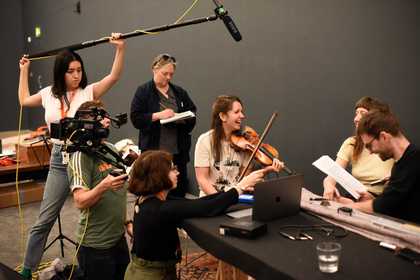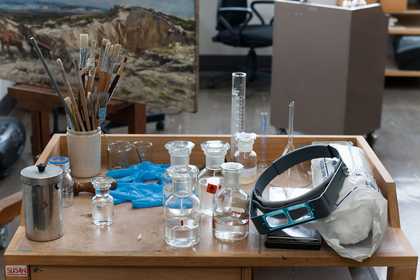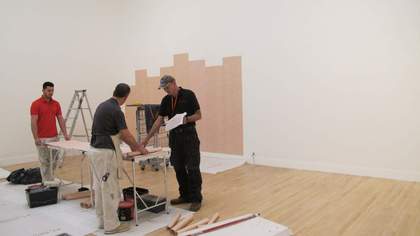
Installation of Susan Hiller’s Belshazzar’s Feast, the Writing on Your Wall 1983–4 at Tate Britain, 2002
Photo © Tate
How is an artwork a living thing? In what ways do artworks change over time?
In this series of audio recordings, you'll hear from Tate staff about their experiences of working with artworks in Tate’s collection.
Conservators, registrars, archivists and researchers discuss how they work together to care for and install artworks.
Introduction
Listen to an introduction to the audio tour by staff working behind the scenes at Tate.
Sarah Cook, Senior Academic Fellow: How did this artwork get here? You might ask this question literally: How did it get into the building? Who installed or assembled it? Who fixed it to the wall? And where does it go when the exhibition closes?
You might hear the question another way: What combination of people, of materials, of technologies brought this artwork to this point?
Ana Ribeiro, Time-based Media Conservator: Every time you install an artwork, it will be installed in a different context.
Jack McConchie, Time-based Media Conservator: Maybe this artwork was asking us to look at what might happen if we tried not to understand so much.
Sarah Haylett, Archives & Records Management Researcher: Every person that interacts with it has the potential to create a new artwork.
Sarah Cook, Senior Academic Fellow: How do artworks change over time? What does it mean to think of an artwork as a living thing? What kind of questions and decisions and ideas are involved when institutions like Tate collect, archive, and display the work of artists?
In this series of audio recordings, you'll hear from people working at Tate. Conservators, registrars, art handling technicians, and archivists. They'll speak about their experiences working with artworks you can see on display. And, along the way, they'll attempt to answer some of these questions.
As you move around the gallery, look out for the yellow QR codes to meet those working behind the scenes at Tate.
Recreating a Picasso Collage
Conservators sometimes make replicas of artworks to learn about what materials and techniques artists use in their work.
Paper Conservator Charity Fox describes her attempts to recreate Pablo Picasso’s collage Bottle of Vieux Marc, Glass, Guitar, and Newspaper 1913.
Charity teaches herself to use the same tools as Picasso, repeating the motions he once made. This connection with the artwork feels like time travel.

A collage under construction replicating Pablo Picasso’s Bottle of Vieux Marc, Glass, Guitar, and Newspaper 1913
Photo: Tate Conservation
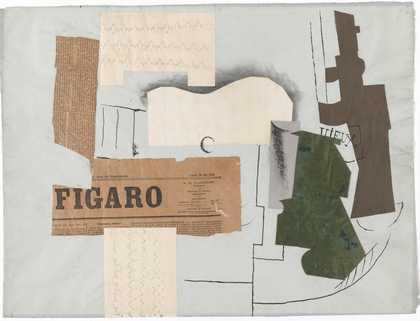
Pablo Picasso
Bottle of Vieux Marc, Glass, Guitar and Newspaper (1913)
Tate
Charity Fox, Paper Conservator: If I were going to pick a reason for loving conservation, it’s that through that contact with the artworks, you can time travel.
I don’t personally feel I get that necessarily just from looking at the artwork. I wanted to work out if it’s possible to share that experience getting as close as possible materially, or remaking, artworks.
Sarah Cook, Senior Academic Fellow: Bottle of Vieux Marc, Glass, Guitar, and Newspaper by Pablo Picasso.
Charity Fox: We’ve tried to make this replica collage as closely as possible with the original materials, or replicas of the original materials. Cutting the collage elements out, making these shapes with my arm with the scissors, it was almost like a sort of performance. I figured I’m probably the only person to have cut these shapes since Picasso did them.
There’s a couple of areas with the collage where Picasso used what we think was a dip pen in ink. Trying to replicate those marks was pretty much impossible for me, given that I’ve never used a dip pen. It just seemed amazing that it was something that every school kid would have been familiar with a hundred years ago, and now I just didn’t have those skills at all – it would take me a few weeks of practising.
The simplest component seemed out of reach.
Installation is a Team Sport
Gates Sofer is a Sculpture & Installation Conservator and Adam Wozniak is a Senior Art Handling Technician. They work closely together when installing artworks in an exhibition.
What do they learn from each other? How is installing art a team activity – ’a little like football’?
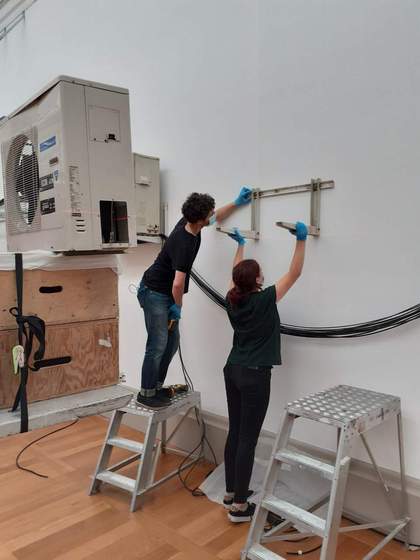
André Figueiredo Silva (Art Handling Technician) and Lily Crew (Art Handling Technician) affix wall brackets during the installation of one of the 11 air conditioning units that comprise Okon’s work (Unbounded [sic]-Vibrational [sic] Always [sic]-on-the-Move [sic]) Praising Flesh (An _Extra aSubjective p,n,e,u,m,a-mode of Being T,o,g,e,t,h,e,r)
Photo: Mikei Hall © Tate
Adam Wozniak, Senior Art Handling Technician: One of the primary responsibilities of being a Senior Art Handling Technician is to manage the storage, movement, installation, deinstallation, general logistics surrounding any artworks that come into the collection at Tate Britain.
Gates Sofer, Sculpture Conservator: During installation, we have the curator, me as the Sculpture Conservator, and an Art Handler. And then, before that, you have the electrician, the decorating team.
I’ll tend to know where things have been broken in the past, or where treatments have occurred, and I’ll let them know these are the areas you need to watch out for. But your experience is slinging, and handling, and actually lifting without anyone getting hurt – including the object. So we both rely on each other in that sense.
Adam Wozniak: Officially, you need three people to handle any artworks. Two people who will actually be holding the object, and then another person who will be guiding those people and creating the sight-lines.
When I first started working within Art Handling, someone mentioned to me it was a little like playing football. It’s such a team sport. It’s choreography, I think, ultimately; that’s what makes it look so simplistic, so easy.
Conserving Uncertainty
Sculpture & Installation Conservator Libby Ireland and Time-based Media Conservator Jack McConchie describe how they’ve worked together to display Ima-Abasi Okon’s artworks.
Okon is open to natural changes that occur to her artistic materials. She is also interested in slowing down and working differently.
Libby and Jack share how they learned to accept and appreciate uncertainty in their work.
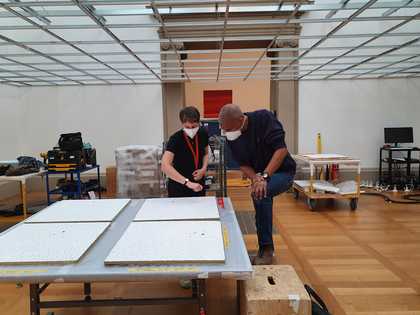
Sculpture Conservator Libby Ireland and Senior Art Handling Technician Mikei Hall inspect the ceiling tiles that form one of the works on display. The tiles have been smeared with a layer of morphine, insulin, ultrasound gel and gold that is invisible to the viewer.
Photo: Pip Laurenson © Tate
Jack McConchie, Time-based Media Conservator: That ceiling structure cuts through the architecture of Tate Britain, just creates a very different atmosphere.
Libby Ireland, Sculpture & Installations Conservator: It is that mixture of things being slightly jarring from the other gallery spaces, but in a calm, reverent kind of way. There’s this slowness, that sense of waiting.
Jack McConchie: A theme that we really found, throughout the project, was this idea of slowness as resistance.
Sarah Cook, Senior Academic Fellow: Works in Tate’s collection, by Ima-Abasi Okon.
Libby Ireland: The display consists of five different works, some of which are codependent on each other. We have a modular ceiling tile system, modified by the artist, in that she’s taken existing ceiling tiles that you find in office spaces, and then she’s smeared them with a mixture of insulin, gold, morphine, and ultrasound gel.
Ima is very open to the natural change that can occur. You see those modular ceilings in loads of different spaces, and often they do look a bit sad, a bit unloved. You’ll have some broken tiles, some water staining. She is interested in objects doing what they do, deteriorating in the way that they would.
Through this process we’ve become a bit better at being okay with not knowing – things not being tied up in a nice bow.
Jacob Epstein, Sun God / Primeval Gods
Jacob Epstein’s Sun God / Primeval Gods is a 2.7-tonne sculpture made of Hoptonwood stone.
Laura Murphy, a Long Loans Registrar, tells us about how this artwork came to Tate. You’ll hear how this artwork has been loaned from the Metropolitan Museum of Art in New York City.
Laura also explains how you safely move a heavy sculpture through the galleries.
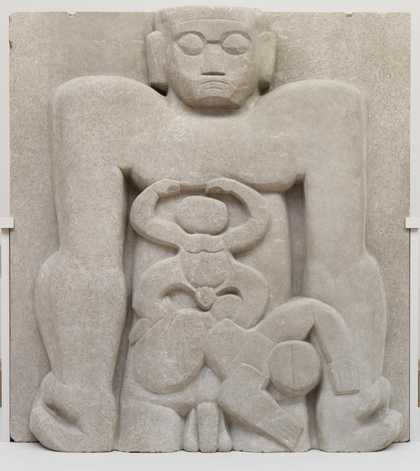
Sir Jacob Epstein
Sun God (verso: Primeval Gods) (1910, 1931–1933)
Lent by the Metropolitan Museum of Art, New York
Laura Murphy, Long Loans Registrar: The artwork was made in two periods of the artist’s life. One side was started in the 1910s. He later returned to this piece of stone a couple of decades later and worked on the other side.
Sarah Cook, Senior Academic Fellow: Sun God and Primeval Gods, by Jacob Epstein.
Laura Murphy: This work isn’t owned by Tate, but the Metropolitan Museum of Art has very generously lent it to us. Long loans are a brilliant way of being able to tell a story about a certain gap in the collection.
We don’t have many examples of the artist’s work from the 1930s, so we’ve chosen to display that side out in towards the rest of the gallery, the one that you see first upon entering.
Because of the size and the weight of it – it’s 2.7 tonnes – it was moved using a gantry, a huge piece of equipment like a crane. The load bearing, which means how much weight different floors within the gallery can take, will have had to have been taken into consideration, so that we don’t create a massive hole in the floor, or risk any damage to the artwork itself.
Kim Lim, Intervals I / Intervals II
Intervals I and Intervals II are two works created by Kim Lim. The artist has said that each work can be installed in different arrangements.
Sculpture Conservator Gates Sofer and Senior Art Handling Technician Adam Wozniak discuss the artist’s instructions, and how this gives the artworks a new life wherever they’re installed.

Kim Lim
Intervals I and Interval II 1973
Tate
© The estate of Kim Lim
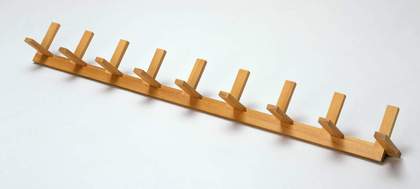
Kim Lim
Intervals II 1973
Tate
© The estate of Kim Lim
Gates Sofer, Sculpture & Installation Conservator: The artwork is a hard piece of wood, and yet it becomes so many different things in so many different ways to so many different people depending on how they choose to display it.
Sarah Cook, Senior Academic Fellow: Intervals I and II, by Kim Lim.
Gates Sofer: There’s a note from the Modern Curator, back when it was acquired, detailing how many different variations there are for installation.
Adam Wozniak, Senior Art Handling Technician: I understand they can also be laid on the ground, Intervals II specifically, with the protruding arms up in the air interlocking, so it can be a long, flat sculpture.
Gates Sofer: I like the colour of the wood, and the grain pattern. Especially in this display, where the wall behind it is a beautiful blue colour, it really offsets the yellowy-orange tone of the wood. I think that’s gorgeous. The way the light plays against the wall, creating shadows of each of the rungs of the ladder, it gives it another dynamic, another dimension.
Adam Wozniak: I think there's definitely something quite electric about it aesthetically, with its simplicity.
Gates Sofer: It also plays off the prints that are around it. It ties it all together, showing how she works with different materials and different techniques.
Adam Wozniak: I think the way that this has multiple configurations, and it has that kind of fluidity, enables it to live a new life wherever it’s installed.
Susan Hiller, Belshazzar’s Feast
Listen to two responses to Susan Hiller’s shape-shifting video installation Belshazzar’s Feast, the Writing on Your Wall 1983–4.
Hiller has revisited the work many times since its first installation in 1984. Different versions of the work include a ‘Campfire Version’ and ‘Bonfire Version’.
Have you noticed the wallpaper in the installation? This part of the artwork is remade each time. Charity Fox talks about the challenges this poses to paper conservators at Tate.
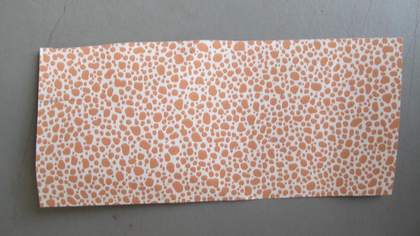
A sample of the wallpaper used for Belshazzar’s Feast retained for reference purposes by Tate’s Conservation team
Photo: Tate Conservation

Susan Hiller
Belshazzar’s Feast, the Writing on Your Wall (1983–4)
Tate
Charity Fox, Paper Conservator: I notice the paper before I notice anything. Which is an odd thing, because I expect the paper is supposed to be the least noticeable thing.
I don’t think I’ve ever been in this room and not gone up super close and looked at the wallpaper, and I feel like I haven’t quite seen the room until I do that. It’s such a ‘paper nerd’ thing to do.
Sarah Cook, Senior Academic Fellow: Belshazzar’s Feast, the Writing on Your Wall, by Susan Hiller.
Charity Fox: The actual pieces of paper that we put up have a finite lifespan, and we won’t reuse. At deinstallation, they’ll be taken from the wall, and the wall painted fresh, and that will be it.
The original wallpaper was just available to purchase. I think it was around£35 a roll. The most time-consuming part of the artwork for a paper conservator is the bit that’s not really considered artwork as such – it’s part of it, but we remake it every time.
One of the things we look at is trying to forecast ahead for when technologies will make it almost impossible to replicate an artwork. As long as we can carry on screen-printing, then we’re fine with this one.
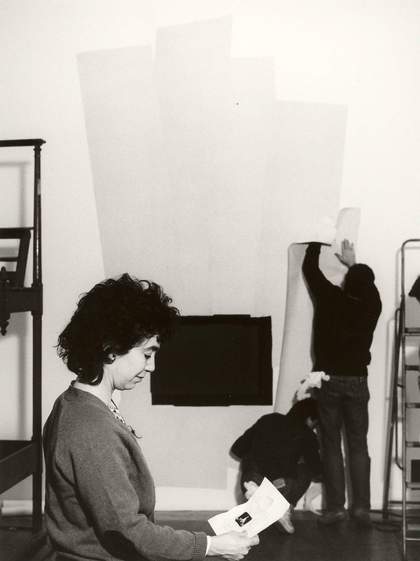
Susan Hiller oversees the first installation of Belshazzar’s Feast, the Writing on Your Wall 1983–4 at Tate Gallery in 1985
Photo © Tate
Sarah Cook, Senior Academic Fellow: Belshazzar’s Feast, the Writing on Your Wall, by Susan Hiller.
Stephen Huyton, Collection Registrar: Apart from the full installation version that’s at Tate, there’s also a ‘Campfire Version’, where the video component of the work is displayed on four monitors, placed on the ground face outwards, and the viewers can sit round those monitors, as if they were around a campfire.
There’s also a ‘Bonfire Version’, where multiple monitors are stacked on top of each other to resemble a bonfire.
Even though they appear very distinct from each other, they all represent the same work.
Within the museum our working practices all gear towards documenting a single version of an artwork.
Behind what you see in the gallery in that moment, there might also be these other versions of the work. Especially when the work is in Store, and not on display, at that moment it has the capacity to be displayed in all different ways.
Rose English, Quadrille
Rose English’s Quadrille has taken many forms. Starting as an installation of sculptures, it then became a performance at Southampton Horse Show in 1975. Decades later, English transformed it into the installation you can see in Tate’s collection today. This installation includes photographs and a video of the 1975 performance, as well as the performer’s costumes.
Ana Ribeiro is a Time-based Media Conservator. She works on the conservation of films, videos and performances. Ana shares what she has learned from watching the video documentation of Rose English’s Quadrille. How do conservators learn from artists?
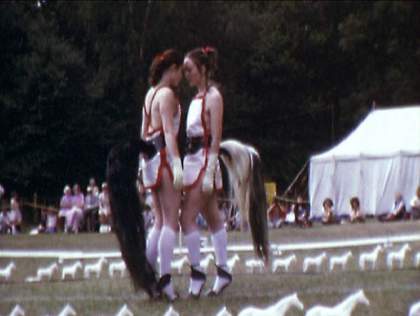
Video still from first performance of Rose English’s Quadrille at Southampton Horse Show in 1975
© Rose English, 2015. All rights reserved. Courtesy Karsten Schubert, London
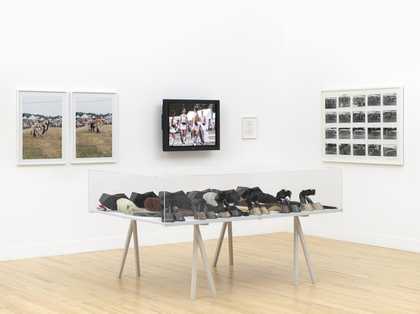
Rose English
Quadrille (1975, 2013)
Tate
© Rose English, 2015. All rights reserved. Courtesy Karsten Schubert, London.
Ana Ribeiro, Time-based Media Conservator: Is it digital? Was it recorded in film? Was there communication between the cameraperson and the performers?
Sarah Cook, Senior Academic Fellow: Quadrille, by Rose English
Ana Ribeiro: Can we understand from the video the purpose of filming? Was it purely for archival reasons? Was it for aesthetic reasons? Was it with the idea of creating another artwork?
This artwork Quadrille originated in a performance that took place at the Southampton Horse Show in 1975.
I don’t know if I would describe it solely as the documentation of that event. I don’t see a static camera. I see a camera that follows the performers. The way it was recorded, the editing choices, you see shots from afar, and others that focus a lot on detail. You see glimpses of the performance.
The idea of disrupting a space that was not a contemporary art space – would it work today? Was that the reason why they decided to put an installation together, rather than performing the artwork, because it was really site-specific – I would even say, event-specific?
What do you think people thought at the time? Do you think they felt uncomfortable? Does this make you feel uncomfortable?
Donald Rodney, Autoicon
What’s on this CD? In the Archive Gallery at Tate Britain, a CD-ROM and its jewel case are on display. The CD-ROM contains a copy of Donald Rodney’s internet artwork Autoicon 2000.
Archives & Records Management Researcher Sarah Haylett describes the origin of this artwork, and how it lives on in Tate Archive.
You can learn more about Autoicon by visiting Iniva’s website.
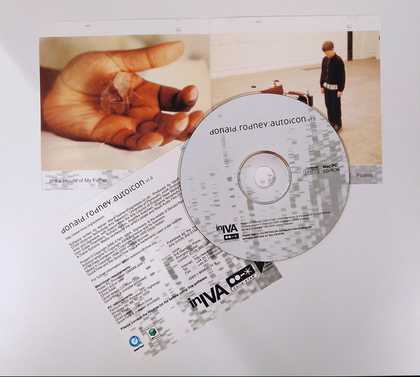
Donald Rodney
Autoicon 2000
CD-ROM, slipcase and information booklet
© Estate of Donald Rodney
Sarah Haylett, Archives & Records Management Researcher: I’m very interested in these ideas of artworks that trouble boundaries. Should it be in the Archive, or should it be in the main collection?
Sarah Cook, Senior Academic Fellow: Autoicon, by Donald Rodney.
Sarah Haylett: Sketchbooks, drawings, photographs, information about the work being produced, correspondence around the work: those are the things that usually come into the archive, and then the final piece of art would go into the art collection. But those get blurred in an art museum.
This CD-ROM holds Autoicon, an internet work conceived by Donald Rodney towards the end ofhis life. He had startd to conceive it before he passed away. He knew he was unwell, and he was delegating more tasks to those people around him—his collaborators and his friends and his partner.
It doesn’t exist as a website anymore. It exists as this archival object.
How to describe what the work is? It’s text, it’s images, it’s ideas, it’s notebook entries, photographs of other works. As the user, you navigate yourself around it and you pull these things together. Every person who interacts with it has the potential to create a new artwork.

